Laws of Chemical Combinations - Class 11 PDF Download
LAWS OF CHEMICAL COMBINATIONS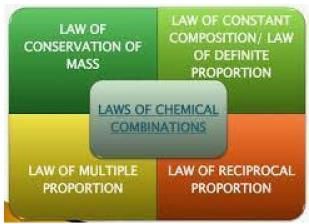 In order to understand the composition of the compounds, it is necessary to have a theory which accounts for both qualitative and quantitative observations during chemical changes. Observations of chemical reactions were most significant in the development of a satisfactory theory of the nature of matter. These observations of chemical reactions are summarized in certain statements known as laws of chemical combination.
In order to understand the composition of the compounds, it is necessary to have a theory which accounts for both qualitative and quantitative observations during chemical changes. Observations of chemical reactions were most significant in the development of a satisfactory theory of the nature of matter. These observations of chemical reactions are summarized in certain statements known as laws of chemical combination.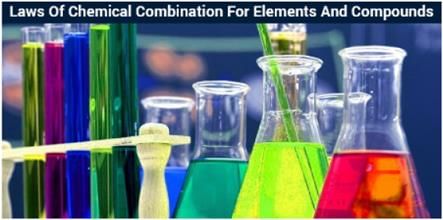
(1) Law of conservation of mass [Lavoisier]
"In a chemical change, total mass remains conserved i.e. mass before the reaction is always equal to mass after the reaction."
mass before the reaction = 1 × 2 + 1 / 2 × 32 = 18 gm
mass after the reaction = 1 × 18 = 18 gm.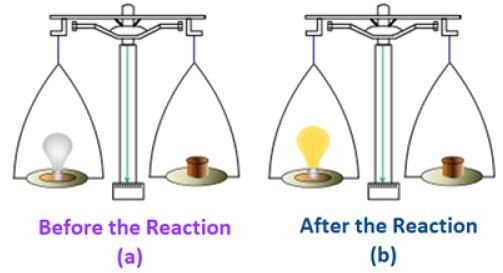
Law of conservation of mass
Example.1. A 15.9 gm sample of sodium carbonate is added to a solution of acetic acid weighing 20.0 gm. The two substances react, releasing carbon dioxide gas to the atmosphere. After the reaction, the contents of the reaction vessel weigh 29.3 gm. What is the mass of carbon dioxide given off during the reaction?
Solution. The total mass of reactants taken = 15.9 + 20.0 = 35.9 gm.
From the conservation of mass, the final mass of the contents of the vessel should also be 35.9 gm. But it is only 29.3 gm. The difference is due to the mass of released carbon dioxide gas.
Hence, the mass of carbon dioxide gas released = 35.9 - 29.3 = 6.6 gm.
Example.2. 5.2 g of CaCO3 when heated produced 1.99 g of Carbon dioxide and the residue (CaO) left behind weighs 3.2 g. Show that these results illustrate the law of conservation of mass.
Solution. Weight of CaCO3 taken = 5.2 g
Total weight of the products (CaO +CO )= 3.20+ 1.99 = 5.19 g
Difference between the wt. of the reactant and the total wt. of the products
= 5.20 – 5.19 =0.01 g.
This small difference may be due to experimental error.
Thus law of conservation of mass holds good within experimental errors.
(2) Law of constant composition [Proust]
"All chemical compounds are found to have constant composition irrespective of their method of preparation or sources."
⇒ In H2O, Hydrogen & oxygen combine in 2 : 1 molar ratio, this ratio remains constant whether it is Tap water, river water or seawater or produced by any chemical reaction.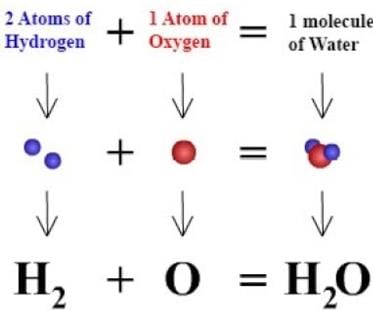
Law of constant composition
Example.1. The following are results of analysis of two samples of the same or two different compounds of phosphorus and chlorine. From these results, decide whether the two samples are from the same or different compounds. Also state the law, which will be obeyed by the given samples. Solution. The mass ratio of phosphorus and chlorine in compound A,
Solution. The mass ratio of phosphorus and chlorine in compound A,
mP : mCl = 1.156 : 3.971 = 0.2911 : 1.000
The mass ratio of phosphorus and chlorine in compound B,
mP : mCl = 1.542 : 5.297 = 0.2911 : 1.000
As the mass ratio is the same, both the compounds are same and the samples obey the law of definite proportion.
Example.2. 6.488 g of lead combine directly with 1.002 g of oxygen to form lead peroxide PbO2. Lead peroxide is also produced by heating lead nitrate and it was found that the percentage of oxygen present in lead peroxide is 13.38 percent. Use these data to illustrate the law of constant composition.
Solution. Step 1 : To calculate the percentage of oxygen in first experiment.
Weight of peroxide formed
= 6.488 + 1. 002 = 7.490 g.
7. 490 g of lead peroxide contain 1.002 g of oxygen
∴ 100 g of lead peroxide will contain oxygen
i.e. oxygen present = 13.38%
Step 2 : To compare the percentage of oxygen in both the experiments.
Percentage of oxygen in PbO2 in the first experiment = 13.38
Percentage of oxygen in PbO2 in the second experiment = 13.38
Since the percentage composition of oxygen in both the samples of PbO2 is identical, the above data illustrate the law of constant composition.
Try Yourself!
Q. 2.8 g of calcium oxide (CaO) prepared by heating limestone were found to contain 0.8 g of oxygen. When one gram of oxygen was treated with calcium, 3.5 g of calcium oxide were obtained. Show that the results illustrate the law of definite proportions.
(3) Law of multiple proportions [Dalton]
"When one element combines with the other element to form two or more different compounds, the mass of one element, which combines with a constant mass of the other bear a simple ratio to one another."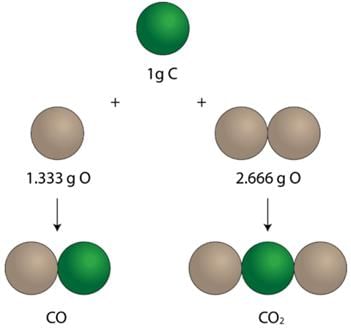
Law of multiple proportions
⇒ Carbon is found to form two oxides which contain 42.9% & 27.3% of carbon respectively show that these figures shows the law of multiple proportion.
In the first oxide, 57.1 parts by mass of oxygen combines with 42.9 parts of carbon. 1 part of oxygen will combine with 42.9/57.1 = 0.751 part of carbon Similarly in 2nd oxide, 1 part of oxygen will combine with 27.3 / 72.7 = 0.376 part of carbon. The ratio of carbon that combine with the same mass of oxygen = 0.751 : 0.376 = 2 : 1. This is a simple whole no. ratio, this means above data shows the law of multiple proportions.
Example.1. Two oxide samples of lead were heated in the current of hydrogen and were reduced to the metallic lead. The following data were obtained
(i) Weight of yellow oxide taken = 3.45 gm; Loss in weight during reduction = 0.24 gm
(ii) Weight of brown oxide taken = 1.227 gm; Loss in weight during reduction = 0.16 gm.
Show that the data illustrates the law of multiple proportion.
Solution. When the oxide of lead is reduced in the current of hydrogen, metallic lead is formed. Definitely, the loss in weight is due to removal of the oxygen present in the oxide, to combine with the hydrogen. Therefore, the composition of the yellow oxide is: Oxygen = 0.24 gm and lead = 3.45 - 0.24 = 3.21 gm.
The mass ratio of lead and oxygen, r1 = mPb / mo = 3.21 / 0.244 = 13.375 / 1.000 and the composition of the brown oxide is : oxygen = 0.16 gm and lead = 1.227 - 0.16 = 1.067 gm.
The mass ratio of lead and oxygen, r2 = mPb / mo = 1.067 / 0.16 = 6.669 / 1.000
Now, r1 : r2 = 13.375 : 6.669 = 2 : 1 (simple ratio) and hence the data illustrates the law of multiple proportion.
Example.2. Carbon is found to form two oxides, which contain 42.9% and 27.3% of carbon respectively. Show that these figures illustrate the law of multiple proportions.
Solution. Step 1 : To calculate the percentage composition of carbon and oxygen in each of the two oxides
(by difference)
Step 2 : To calculate the weights of carbon which combine with a fixed weight i.e., one part by weight of oxygen in each of the two oxides.
In the first oxide, 57.1 parts by weight of oxygen combine with carbon = 42.9 parts.
∴ 1 part by weight of oxygen will combine with carbon 42.9 / 57.1 = 0.751
In the second oxide 72.7 parts by weight of oxygen combine with carbon = 27.3 parts.
∴ 1 part by weight of oxygen will combine with carbon 27.3 / 72.7 = 0.376
Step 3 : To compare the weights of carbon which combine with the same weight of oxygen in both the oxides. The ratio of the weights of carbon that combine with the same weight of oxygen (1 part) is 0.751 : 0.376 or 2 : 1
Since this is a simple whole number ratio, so the above data illustrate the law of multiple proportions.
(4) Law of reciprocal proportions [Richter]
"When two elements combine separately with definite mass of a third element, then the ratio of their masses in which they do so is either the same or some whole number multiple of the ratio in which they combine with each other."
This law can be understood easily with the help of the following examples.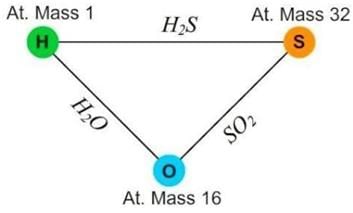
Law of reciprocal proportions
⇒ Let us consider three elements: Hydrogen, Sulphur and Oxygen.
Hydrogen combines with oxygen to form H2O whereas sulphur combines
with it to form SO2. Hydrogen and sulphur can also combine together to form H2S. The formation of these compounds is shown in fig.
In H2O, the ratio of masses of H and O is 2 : 16.
In SO2, the ratio of masses of S and O is 32 : 32. Therefore, the ratio of masses of H and S which combines with a fixed mass of oxygen (say 32 parts) will be 4 : 32 i.e. 1 : 8 ...(i)
When H and S combine together, they form H2S in which the ratio of masses of H and S is 2 : 32 i.e. 1 : 16 ...(ii)
The two ratios (i) and (ii) are related to each other as or 2 : 1.i.e., they are whole number multiples of each other.
Thus, the ratio of masses of H and S which combines with a fixed mass of oxygen is a whole number multiple of the ratio in which H and S combine together.
Example.1. Methane contains 75 % carbon and 25% hydrogen, by mass.
Carbon dioxide contains 27.27 % carbon and 72.73% oxygen, by mass. Water contains 11.11 % hydrogen and 88.89% oxygen, by mass.
Show that the data illustrates the law of reciprocal proportion.
Solution. Methane and carbon dioxide, both contain carbon and hence, carbon may be considered as the third element. Now, let the fixed mass of carbon = 1 gm. Then, the mass of hydrogen combined with 1 gm carbon in methane = 25 / 75 = 1 / 3 gm and the mass of oxygen combined with 1 gm carbon in carbon dioxide = 72.73 / 27.27 = 8 / 3 gm.
Hence, the mass ratio of hydrogen and oxygen combined with the fixed
mass of carbon, r = 1 / 3 : 8 / 3 = 1 / 8.
Now, the mass ratio of hydrogen and oxygen in water, r2 = 11.11 / 88.89 = 1 / 8
As r1 and r2 are same , the data is according to the law of reciprocal proportion.
Example.2. Copper sulphide contains 66.6% Cu, copper oxide contains 79.9% copper and sulphur trioxide contains 40% Sulphur. Show that these data illustrates law of reciprocal proportions.
Solution. In copper sulphides Cu : S mass ratio is 66.6 : 33.4
In sulphur trioxide Oxygen : Sulphur (O:S) mass ratio is 60 : 40
Now in CuS 33.4 parts of sulphur combines with Cu = 66.6 parts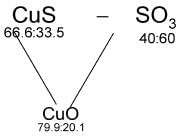 40.0 parts of sulphur combines with cu = 66.6 x 40 / 33.4 = 79.8 parts
40.0 parts of sulphur combines with cu = 66.6 x 40 / 33.4 = 79.8 parts
Now the ratio of masses of Cu and O which combines with same mass (40 parts) of sulphur separately is 79.8 : 60 …(1)
Cu : O ratio by mass in CuO is 79.9 : 20.1 …(2)
Ratio 1 : Ratio 2 =
Which is simple whole number ratio, hence law of reciprocal proportion is proved.
Try Yourself
Q. 61.8 g of A combines with 80 g of B. 30.9 g of A combines with 106.5 g of C, B and C combine to form compound . Atomic weight of C and B are respectively 35.5 and 6.6. Show that the law of reciprocal proportion is obeyed.
(5) Gay Lussac's law of combining volumes
"When two or more gases react with one another, their volumes bear simple whole number ratio with one another and to the volume of products (if they are also gases) provided all volumes are measured under identical conditions of temperature and pressure."
When gaseous hydrogen and gaseous chlorine react together to form gaseous hydrogen chloride according to the following equation. It has been observed experimentally that in this reaction, one volume of hydrogen always reacts with one volume of chlorine to form two volumes of gaseous hydrogen chloride. all reactants and products are in gaseous state and their volumes bear a ratio of 1 : 1 : 2. This ratio is a simple whole number ratio.
Gay Lussac's Law of combining volumes
These are no longer useful in chemical calculations now but gives an idea of earlier methods of analyzing and relating compounds by mass.
Example.1. 2.5 ml of a gaseous hydrocarbon exactly requires 12.5 ml oxygen for complete combustion and produces 7.5 ml carbon dioxide and 10.0 ml water vapour. All the volumes are measured at the same pressure and temperature. Show that the data illustrates Gay Lussac's law of volume combination.
Solution. Vhydrocarbon : Voxygen : Vcarbon dioxide : Vwater vapour = 2.5 : 12.5 : 7.5 : 10.0 = 1 : 5 : 3 : 4 (simple ratio)
Hence, the data is according to the law of volume combination.
Example.2. How much volume of oxygen will be required for complete combustion of 40 ml of acetylene (C2H2) and how much volume of carbon dioxide will be formed? All volumes are measured at NTP.
Solution. 

So for complete combustion of 40 ml of acetylene, 100 ml of oxygen are required and 80 ml of CO2 is formed.
OBJECTIVE QUESTIONS
Q.1. Two oxides of a certain metal were separately heated in a current of hydrogen until constant weight were obtained. The water produced in each case was carefully collected and weighed. 2 g of each oxide gave 0·2517 g and 0·4626 g of water respectively. This observation illustrates
(a) Law of conservation of mass
(b) Law of constants proportions
(c) Low of multiple proportions
(d) Law of reciprocal proportions
Ans. (c)
Solution. 1st oxide : Oxygen present in 0·2517 g H2O
= × 0·2517 g = 0·224 g
Metal present =2 - 0·224 g = 1·776 g
2nd oxide : Oxygen present in 0·452 g H2O
= Loading… × 0·4526 g = 0·402 g
Metal present =2 - 0·402 g = 1·598 g
Masses of oxygen which combine with fixed mass (1g) of metal in the two oxides = Loading… and Loading… g = 0·126 g and 0·252 g, i.e. in the ratio 1 : 2.
Hence, it illustrates law of multiple proportions.
Q.2. The mass of nitrogen per gram hydrogen in the compound hydrazine is exactly one and half time the mass of nitrogen in the compound, ammonia. The fact illustrates:
(a) The law of conservation of mass
(b) The multiple valency of nitrogen
(c) The law of multiple proportions
(d) The law of definite proportions
Ans. (c)
Solution. Ratio of masses of nitrogen per gram of hydrogen in hydrazine (N2H4) and NH3
= 1 Loading… : 1= Loading… : 1 = 3 : 2
Which is a simple whole no ratio. This illustrates the law of multiple proportions
Q.3. The percentage of copper and oxygen in samples of CuO obtained by different methods were found to be the same. This illustrates the law of
(a) Constant proportions
(b) Conservation of mass
(c) Multiple proportions
(d) Reciprocal proportions
Ans. (a)
Solution. Based on definition of low of constant proportions.
Q.4. Two samples of lead oxide were separately reduced to metallic lead by heating in a current of hydrogen. The weight of lead from one oxide was half the weight of lead obtained the other oxide. The data illustrate
(a) Law of reciprocal proportions
(b) Law of constant proportions
(c) Law of multiple proportions
(d) Law of equivalent proportions
Ans. (c)
Solution. This shows that the weights of lead combining with fixed weight of oxygen are in the ratio Loading… : 1 or 1 : 2 which is in accordance with law of multiple proportions.
Q.5. One part of an element X combines with two parts of another element B. Six parts of the element C combine with four parts of the element B. If A and C combine together, the ratio of their weights will be governed by
(a) Law of definite proportions
(b) Law of multiple proportions
(c) Law of reciprocal proportions
(d) Law of conservation of mass
Ans. (c)
Solution. Law of reciprocal proportions (by definition)
Q.6. Two gaseous sample were analysed . One contained 1·2 g of carbon and 3·2 g of oxygen. The other contained 27·3% carbon and 72·7% oxygen. The experimental data are in accordance with
(a) Law of conservation of mass
(b) Law of definite proportions
(c) Law of reciprocal proportions
(d) Law of multiple proportions
Ans. (b)
Solution. % of C in the 1 st sample = Loading… × 100 = 27·3% which is same as in the 2nd sample. Hence, law of definite proportions is obeyed
Try yourself!
Q.1. What mass of silver nitrate will react with 5.85 g of sodium chloride to produce 14.35 g of silver chloride and 8.5 g of sodium nitrate, if the law of conservation of mass is true?
Ans. According to the law of conservation of mass, the mass of the products in a chemical reaction must equal the mass of the reactants.
For the chemical reaction: AgNO3 + NaCI → NaNO3 + AgCI
mreactants = mproducts
mAgNO3 + mNaCl = mNaNO3 + mAgCl
x + 5.85 = 8.5 + 14.35 x
= 17.0 g
Q.2. Elements X and Y form two different compounds. In the first, 0.324 g of X is combined with 0.471 g of Y. In the second, 0.117 g of X is combined with 0.509 g of Y. Show that these data illustrate the law of multiple proportions
Ans. According to the law of multiple proportions, "If two elements form more than one compound between them, then the ratios of the masses of the second element which combine with a fixed mass of the first element will be ratios of small whole numbers".
In the first compound, 0.324 g of X is combined with 0.471 g of Y.
Hence, 1 g of X is combined with 0.471/0.324 = 1.45 g of Y.
In the second compound, 0.117 g of X is combined with 0.509 g of Y.
Hence, 1 g of X is combined with 0.1170.509 = 4.35 g of Y.
The ratio 1.454.35 = 13 is a small whole number.
Q.3. Carbon dioxide contains 27.27% of carbon, carbon disulphide contains 15.79% of carbon and sulphur dioxide contains 50% of sulphur. Are these figures in agreement with the law of reciprocal proportions?
Ans. In CO2, 27.27% C and 72.73% O is present.
Ratio of C to O = C : O = 27.27 : 72.73 = 1 : 2667 ⟶ (i)
In CS2, 15.97% C and 84.03% of S is present.
Ratio of C to S = C : S
1g of C combines with = 15.7984.21 = 5.33g of S ⟶ (ii)
The ratio of different masses of S & O combining with fixed mass of C is 5.33 : 2.67 i.e. 2 : 1 ⟶ (iii)
In SO2, 50% of sand 50% of O is present.
∴ Rate of S to O = 50 : 50 = 1 : 1 ⟶ (iv)
The data illustrates the law of reciprocal proportions.
The ratio of different masses of S and O combining with fixed mass of carbon is a simple whole number.



















